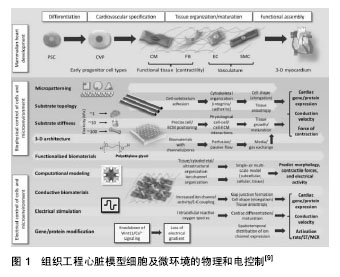| [1] Yang X, Zhou Y, Li H, et al. Mesenchymal stem cells as a gene delivery system to create biological pacemaker cells in vitro. J Int Med Res.2008;36(5):1049-1055. [2] Cho HC, Kashiwakura Y, Marban E. Creation of a biological pacemaker by cell fusion. Circ Res.2007;100(8): 1112-1115. [3] Holnthoner W, Hohenegger K, Husa AM,et al. Adipose-derived stem cells induce vascular tube formation of outgrowth endothelial cells in a fibrin matrix. J Tissue Eng Regen Med.2012;9(2):127-136. [4] Zimmermann WH, Melnychenko I, Eschenhagen T.Engineered heart tissue for regeneration of diseased hearts.Biomaterials. 2004;25(9):1639-1647.[5] Marvin WJ Jr, Chittick VL, Rosenthal JK, et al.The isolated sinoatrial node cell in primary culture from the newborn rat.Circ Res.1984;55(2):253-260.[6] Fukuda K. Development of Regenerative Cardiomyocytes from Mesenchymal Stem Cells for Cardiovascular Tissue Engineering .Artif Organs.2001;25(3):187-193.[7] Zhang X, Zhang CS, Liu YC,et al. Isolation, culture and characterization of cardiac progenitor cells derived from human embryonic heart tubes.Cells Tissues Organs. 2009; 190(4):194-208. [8] 付金利, 廖斌.组织工程窦房结支架材料的选择与展望[J].中国组织工程研究与临床康复, 2007,11(5): 940-943.[9] Thavandiran N, Nunes SS, Xiao Y, et al.Topological and electrical control of cardiac differentiation and assembly. Stem Cell Res Ther. 2013; 4(1):14.[10] Peña B, Martinelli V, Jeong M,et al.Biomimetic Polymers for Cardiac Tissue Engineering.Biomacromolecules. 2016;17(5): 1593-1601. [11] Tian B, Liu J, Dvir T, et al. Macroporous nanowire nanoelectronic scaffolds for synthetic tissues.Nat Mater. 2012;(11):986-994. [12] Wu Y, Shi X, Li Y, et al. Carbon Nanohorns Promote Maturation of Neonatal Rat Ventricular Myocytes and Inhibit Proliferation of Cardiac Fibroblasts: a Promising Scaffold for Cardiac Tissue Engineering.Nanoscale Res Lett.2016;11(1):284.[13] Geim AK. Graphene: status and prospects.Science. 2009; 324(5934):1530-1534[14] Bitounis D, Ali-Boucetta H, Hong BH, et al.Prospects and challenges of graphene in biomedical applications.Adv Mater. 2013;25(16):2258-68. [15] Schinwald A, Murphy FA, Jones A,,et al. Graphene-based nanoplatelets: a new risk to the respiratory system as a consequence of their unusual aerodynamic properties.ACS Nano. 2012;6(1):736-46. [16] Shin SR, Zihlmann C, Akbari M, et al. Reduced Graphene Oxide-GelMA Hybrid Hydrogels as Scaffolds for Cardiac Tissue Engineering. Small. 2016;12(27):3677-3689.[17] Naderi H, Matin MM, Bahrami AR.Review paper:Critical Issues in Tissue Engineering: Biomaterials, Cell Sources, Angiogenesis, and Drug Delivery Systems.J Biomater Appl. 2011;26(4):383-417 .[18] Baumgartner I, Pieczek A, Manor O,et al.Constitutive expression of phVEGF165 after intramuscular gene transfer promotes collateral vessel development in patients with critical limb ischemia. Circulation. 1998;97(12):1114-1123.[19] Dew L, MacNeil S. Chong CK.Vascularization strategies for tissue engineers.Regen Med,2015;10(2):211-224 . [20] Sato M, Yamato M, Hamahashi K, et al. Articular cartilage regeneration using cell sheet technology.Anat Rec(Hoboken), 2014;297(1):36-43. [21] Choudhury M, Boyett MR, Morris GM.Biology of the Sinus Node and its Disease.Arrhythm Electrophysiol Rev.2015;4(1): 28-34. [22] Okano T, Yamada N, Sakai H.A novel recovery system for cultured cells using plasma-treated polystyrene dishes grafted with poly(N-isopropylacrylamide). J Biomed Mater Res.1993; 27(10):1243-1251.[23] Sekine H, Shimizu T, Hobo K,et al.Endothelial cell coculture within tissue-engineered cardiomyocyte sheets enhances neovascularization and improves cardiac function of ischemic Hearts. Circulation. 2008 ;118(14 Suppl):S145-152. [24] Sekine H, Shimizu T, Sakaguchi K.In vitro fabrication of functional three-dimensional tissues with perfusable blood vessels. Nat Commun. 2013;4:1399.[25] Sakaguchi K, Shimizu T, Okano T.Construction of three-dimensional vascularized cardiac tissue with cell sheet engineering.J Control Release. 2015;205:83-88.[26] Dvir T, Kedem A, Ruvinov E,et al. Prevascularization of cardiac patch on the omentum improves its therapeutic outcome.Proc Natl Acad Sci U S A. 2009;106(35): 14990-14995. [27] Rouwkema J, Rivron NC, van Blitterswijk CA. Vascularization in tissue engineering. Trends Biotechnol. 2008 ;26(8):434-441.[28] Laschke MW, Harder Y, Amon M, et al. Angiogenesis in tissue engineering :breathing life into constructed tissue substitutes. Tissue Eng,2006;12(8):2093-2104.[29] Lovett M, Lee K, Edwards A, et al. Vascularization strategies for tissue engineering. Tissue Eng Part B Rev. 2009;15(3): 353-370.[30] Baumen H, Mansouri D, Fromont G, et al. Terminal urothelium differentiation of engineered neoureter after in vivo maturation in the “omental bioreactor”. Eur Urol.2007;52(5):1492-1498.[31] Cheng HL, Wallis C, Shou Z,et al.Quantifying angiogenesis in VEGF-enhanced tissue-engineered bladder constructs by dynamic contrast-enhanced MRI using contrast agents of different molecular weights. Magn Reson Imaging. 2007;25(1): 137-145.[32] Chen W, Shi C, Yi S, et al. Bladder regeneration by collagen scaffolds with collagen binding human basic fibroblast growth factor.J Urol. 2010;183(6):2432-2439. [33] Ohashi K, Yokoyama T, Yamato M,et al. Engineering functional two- and three-dimensional liver systems in vivo using hepatic tissue sheets.Nat Med. 2007;13(7):880-885. [34] Wezel F, Southgate J, Thomas DF.Regenerative medicine in urology.BJU Int. 2011;108(7):1046-1065.[35] Maher B. Tissue engineering: How to build a heart.Nature. 2013;499(7456):20-22.[36] Uygun BE,Soto-Gutierrez A,Yagi H,et al.Organ reengineering through development of a transplantable recellularized liver graft using decellularized liver matrix. Nat Med. 2010;16(7): 814-820. [37] Paulsen SJ, Miller JS.Tissue vascularization through 3D printing: Will technology bring us flow? Dev Dyn. 2015; 244(5): 629-640. [38] Marsano A, Maidhof R, Luo J,et al. The effect of controlled expression of VEGF by transduced myoblasts in a cardiac patch on vascularization in a mouse model of myocardial infarction. Biomaterials. 2013;34(2):393-401.[39] Hendrickx B, Vranckx JJ, Luttun A. Cell-based vascularization strategies for skin tissue engineering.issue Eng Part B Rev. 2011;17(1):13-24. [40] Holnthoner W, Hohenegger K, Husa AM.Adipose-derived stem cells induce vascular tube formation of outgrowth endothelial cells in a fibrin matrix.J Tissue Eng Regen Med. 2015;9(2):127-136. [41] Asahara T, Murohara T, Sullivan A, et al. Isolation of putative progenitor endothelial cells for angiogenesis.Science. 1997; 275(5302):964-967.[42] Rouwkema J, Westerweel PE, de Boer J.The use of endothelial progenitor cells for prevascularized bone tissue engineering.Tissue Eng Part A. 2009;15(8):2015-27.[43] He H, Shirota T, Yasui H,et al. Canine endothelial progenitor cell-lined hybrid vascular graft with nonthrombogenic potential.J Thorac Cardiovasc Surg. 2003;126(2):455-464[44] Zhou M, Liu Z, Liu C.Tissue engineering of small-diameter vascular grafts by endothelial progenitor cells seeding heparin-coated decellularized scaffolds.J Biomed Mater Res B Appl Biomater. 2012;100(1):111-20..[45] Chen BS, Xie H, Zhang SL.Tissue engineering of bladder using vascular endothelial growth factor gene-modified endothelial progenitor cells.Int J Artif Organs. 2011;34(12): 1137,1146. [46] 张璐萍.血管化组织工程化窦房结的构建及应用基础研究[D] 上海:第二军医大学.2013. |
.jpg)

.jpg)